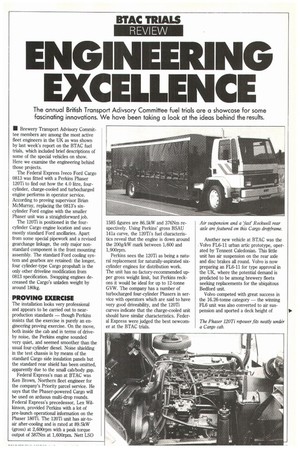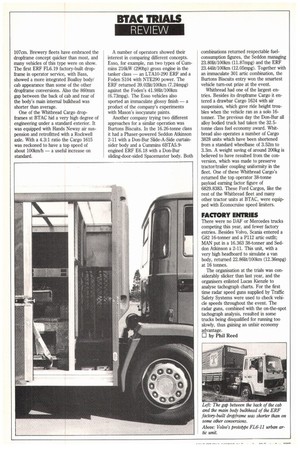ENGINEERING EXCELLENC
Page 49

Page 50

If you've noticed an error in this article please click here to report it so we can fix it.
The annual British Transport Adivsory Committee fuel trials are a showcase for some fascinating innovations. We have been taking a look at the ideas behind the results.
• Brewery Transport Advisory Committee members are among the most active fleet engineers in the UK as was shown by last week's report on the BTAC fuel trials, which included brief descriptions of some of the special vehicles on show. Here we examine the engineering behind those projects.
The Federal Express Iveco Ford Cargo 0813 was fitted with a Perkins Phaser 120Ti to find out how the 4.0 litre, fourcylinder, charge-cooled and turbocharged engine performs in operator service. According to proving supervisor Brian McMurray, replacing the 0813's sixcylinder Ford engine with the smaller Phaser unit was a straightforward job.
The 120Ti is positioned in the fourcylinder Cargo engine location and uses mostly standard Ford ancillaries. Apart from some special pipework and a revised gearchange linkage, the only major nonstandard component is the front mounting assembly. The standard Ford cooling system and gearbox are retained: the longer, four cylinder-type Cargo propshaft is the only other clriveline modification from 0813 specification. Swapping engines decreased the Cargo's unladen weight by around 180kg.
PROVING EXERCISE
The installation looks very professional and appears to be carried out to nearproduction standards — though Perkins insists that the exercise is purely an engineering proving exercise. On the move, both inside the cab and in terms of driveby noise, the Perkins engine sounded very quiet, and seemed smoother than the usual four-cylinder diesel. Noise shielding in the test chassis is by means of the standard Cargo side insulation panels but the standard rear shield has been omitted, apparently due to the small cab/body gap.
Federal Express's man at BTAC was Ken Brown, Northern fleet engineer for the company's Priority parcel service. He says that the Phaser-powered Cargo will be used on arduous multi-drop rounds. Federal Express's precedessor, Lex Wilkinson, provided Perkins with a lot of pre-launch operational information on the Phaser 180Ti. The 120Ti unit has air-toair after-cooling and is rated at 89.5kW (gross) at 2,600rpm with a peak torque output of 387Nm at 1,600rpm. Nett LSO 1585 figures are 86.5kW and 376Nm respectively. Using Perkins' gross BSAU 141a curve, the 120Ti's fuel characteristics reveal that the engine is down around the 200g/kW mark between 1,600 and 1, 90Orpm.
Perkins sees the 120Ti as being a natural replacement for naturally-aspirated sixcylinder engines for distribution work. The unit has no factory-recommended upper gross weight limit, but Perkins reckons it would be ideal for up to 12-tonne GVW. The company has a number of turbocharged four-cylinder Phasers in service with operators which are said to have very good driveability, and the 120Ti curves indicate that the charge-cooled unit should have similar characteristics. Federal Express were judged the best newcomer at the BTAC trials. Another new vehicle at BTAC was the • Volvo FL6-11 urban artic prototype, operated by Tennent Caledonian. This little unit has air suspension on the rear axle and disc brakes all round. Volvo is now preparing an FL6-11 for type approval in the UK, where the potential demand is predicted to be among brewery fleets seeking replacements for the ubiquitous Bedford unit.
Volvo competed with great success in the 16.26-tonne category — the winning FL6 unit was also converted to air suspension and sported a deck height of 107cm. Brewery fleets have embraced the dropframe concept quicker than most, and many vehicles of this type were on show. The first ERF FL6.19 factory-built dropframe in operator service, with Bass, showed a more integrated Boalloy body/ cab appearance than some of the other dropframe conversions. Also the 860mm gap between the back of cab and rear of the body's main internal bulkhead was shorter than average.
One of the Whitbread Cargo dropframes at BTAC hid a very high degree of engineering under a standard exterior. It was equipped with Hands Neway air suspension and retrofitted with a Rockwell axle. With a 4.3:1 ratio the Cargo 1615 was reckoned to have a top speed of about 100Ian/h — a useful increase on standard. A number of operators showed their interest in comparing different concepts. Esso, for example, ran two types of Cummins 216kW (290hp) gross engine in the tanker class — an LTA10-290 ERF and a Foden S104 with NTE290 power. The ERF returned 39.021it/100km (7.24mpg) against the Foden's 41.981it/100km (6.73mpg). The Esso vehicles also sported an immaculate glossy finish — a product of the company's experiments with Mason's isocyanate paints.
Another company trying two different approaches for a similar operation was Burtons Biscuits. In the 16.26-tonne class it had a Phaser-powered Seddon Atkinson 2-11 with a Don-Bur Slide-A-Side curtainsider body and a Cummins 6BTA5.9engined ERF E6.18 with a Don-Bur sliding-door-sided Spacemaster body. Both combinations returned respectable fuelconsumption figures, the Seddon managing 23.801it/100km (11.87mpg) and the ERF 23.44lit/1001cm (12.05mpg). Together with an immaculate 301 artic combination, the Burtons Biscuits entry won the smartest vehicle turn-out prize at the event.
Whitbread had one of the largest entries. Besides its dropframe Cargo it entered a drawbar Cargo 1624 with air suspension, which gave ride height troubles when the vehicle ran as a solo 16tonner. The previous day the Don-Bur all alloy bodied truck had taken the 32.5tonne class fuel economy award. Whitbread also operates a number of Cargo 3828 units which have been shortened from a standard wheelbase of 3.52m to 3.3m. A weight saving of around 200kg is believed to have resulted from the conversion, which was made to preserve tractor/trailer coupling uniformity in the fleet. One of these Whitbread Cargo's returned the top operator 38-tonne payload earning factor figure of 6829.8383. These Ford Cargos, like the rest of the Whitbread fleet and many other tractor units at BTAC, were equipped with Econocruise speed limiters.
FACTORY ENTRIES
There were no DAF or Mercedes trucks competing this year, and fewer factory entries. Besides Volvo, Scania entered a 682 16-tomer and a P112 artic outfit; MAN put in a 16.363 38-tomer and Seddon Atkinson a 2-11. This unit, with a very high headboard to simulate a van body, returned 22.861it/100km (12.36mpg) at 16 tonnes.
The organisation at the trials was considerably slicker than last year, and the organisers enlisted Lucas Kienzle to analyse tachograph charts. For the first time radar speed guns supplied by Traffic Safety Systems were used to check vehicle speeds throughout the event, The radar guns, combined with the on-the-spot tachograph analysis, resulted in some trucks being disqualified for running too slowly, thus gaining an unfair economy advantage.
ID by Phil Reed




































































































































